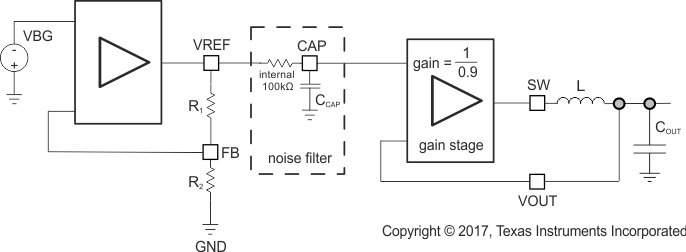SLVSD44A September 2017 – July 2018 TPS63710
PRODUCTION DATA.
- 1 Features
- 2 Applications
- 3 Description
- 4 Revision History
- 5 Pin Configuration and Functions
- 6 Specifications
- 7 Detailed Description
- 8 Application and Implementation
- 9 Power Supply Recommendations
- 10Layout
- 11Device and Documentation Support
- 12Mechanical, Packaging, and Orderable Information
Package Options
Mechanical Data (Package|Pins)
- DRR|12
Thermal pad, mechanical data (Package|Pins)
- DRR|12
Orderable Information
7.3.1 Low Noise Reference System
The reference system in the TPS63710 uses an external filter capacitor on the CAP pin. This reduces the low-frequency (1/f) noise in a range from a lower limit up to around 100kHz. The lower limit is defined by the corner frequency of the RC filter from the internal 100-kΩ resistor and an external capacitor on the CAP pin. The corner frequency is defined by Equation 1.

In order to minimize the noise on the output voltage, the TPS63710 uses an architecture where the output voltage setting is done by changing the reference voltage which then is filtered. The gain stage therefore does not have to have a large gain in order to not increase the noise level. VBG is the internal bandgap reference voltage, optimized for low noise. Its output voltage is amplified and inverted and then filtered. The voltage on the CAP pin is the reference for the gain stage. The connection from CAP to the external capacitor should be as short as possible and be kept away from noisy traces. The gain stage has a small gain of 1/0.9. The voltage at VREF is negative and lower than the output voltage by the gain factor of the gain stage. Please also see Setting the Output Voltage. Figure 8 shows the low noise architecture.
 Figure 8. Low Noise Architecture
Figure 8. Low Noise Architecture